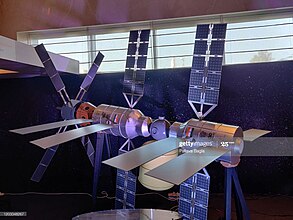Context:
Recently, the Union Cabinet has approved the construction of the first unit of the Bharatiya Antariksh Station, expanding the scope of the Gaganyaan program.
More on the news
- The Gaganyaan program will now consist of eight missions, including four essentials for constructing the BAS.
- ISRO will lead the program, collaborating with industry, academia, and other national agencies.
- ISRO will undertake four missions under the ongoing Gaganyaan program by 2026, along with the development of the first module of BAS and four additional missions for technology demonstration and validation by December 2028.
Four missions under the current Gaganyaan program:
- Chandrayaan-4: The fourth iteration of India’s lunar mission.
- Venus Orbiter Mission (VOM): A new mission aimed at exploring Venus.
- Bharatiya Antariksh Station (BAS): The first unit of India’s indigenous space station, which expands the Gaganyaan program.
- Next Generation Launch Vehicle (NGLV): Development of a new launch vehicle.
Gaganyaan Mission
- Approved in December 2018, to establish the foundation for India’s future human space exploration initiatives.
- It is ISRO’s mission to send Indian astronauts to Low Earth Orbit for a short duration using an Indian launch vehicle.
- Aims to test various technologies essential for human spaceflight, which is the most complex form of space exploration.
About Bharatiya Antariksh Station (BAS)
- It is India’s ambitious space project aimed at establishing a space station that will orbit 400 km above the Earth’s surface.
- The initial version, known as BAS-1, is targeted for launch in 2028, with the full expanded version expected by 2035.
- The station will have a mass of around 52 tonnes and will allow astronauts to stay in orbit for 15 to 20 days.
- It will feature a crew command module, habitat module, propulsion module, and docking ports.
Space Stations
- United States: The International Space Station (ISS), operational since 2000, serves as a hub for global research and collaboration.
- China: The Tiangong Space Station (TSS), operational since June 2022.
- Russia: The Russian Orbital Station (ROS) is set to begin construction in 2027.
Significance of the BAS
- Research Platform: It will enable Indian astronauts and scientists to conduct experiments in microgravity, astronomy, and Earth observation.
- Technology Development: It will serve as a platform for testing and validating new technologies essential for its construction and operation.
- Gateway to Interplanetary Missions: It will facilitate future interplanetary missions and provide an international platform for collaborative space research.
- Economic Impact: To create job opportunities in high-tech sectors related to space and technology.
- Inspiration for Youth: To inspire young people to pursue careers in science and technology, particularly in microgravity research.
- Milestone for Future Missions: It is a crucial step toward establishing India’s space station by 2035, supporting a crewed moon mission by 2040 and advancing space exploration by 2047.

